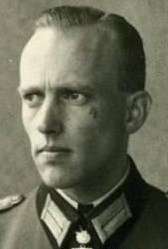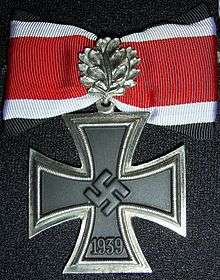Willy Johannmeyer
| Willy Johannmeyer | |
|---|---|
 Oberstleutnant i.G. Willy Johannmeyer wearing his Knight's Cross. The Oak Leaves are visible at the lower part of the photograph. | |
| Born |
27 July 1915 Iserlohn, Westphalia |
| Died |
14 April 1970 (aged 54) Kelkheim, Hessen |
| Allegiance |
|
| Service/branch | |
| Years of service | 1933-1945 |
| Rank | Oberstleutnant im Generalstab |
| Service number | SS Member No. 262992[a] |
| Commands held | 2nd Company, 14th Company, 2nd Battalion of the 503rd Infantry Regiment |
| Battles/wars | |
| Awards | Knight's Cross of the Iron Cross with Oak Leaves |
Willy Johannmeyer (sometimes mistakenly written Willi; 27 July 1915 – 14 April 1970) was a German officer during World War II. He was also a recipient of the Knight's Cross of the Iron Cross with Oak Leaves, and, by the time of the dissolution of the Third Reich, the last adjutant to Adolf Hitler of the army (Heeresadjutant).[2]
Military career
Interwar period
Willy Johannmeyer was born in Iserlohn, Westphalia, on 27 July 1915[1][2] After Adolf Hitler's rise to power in 1933, he joined the SS, becoming member No. 262992. [a] [1] In 1936, he assigned to the 64th Infantry Regiment [2] as Cadet (Fahnenjunker)[1] and two years later, he rose to the rank of Leutnant.[2] By 1939, he was the leader of the Signal Corps training centre of the 503rd Infantry Regiment.[2]
World War II
Johannmeyer took part in the invasion of France, having been appointed leader of the regiment's 2nd Company on 1 April 1940.[2] In April 1941 he was transferred to the 14th Company of the regiment.[2] Subjected to the Army Group North, the regiment fought mainly at the Leningrad front, after the invasion of the Soviet Union (Operation Barbarossa). Because of his excellent leading skills, he was soon appointed commander of the 2nd Battalion on 1 April 1942.[2] There, for actions during the battles around the Lake Ilmen (May 1942), he was awarded the highest award of Nazi Germany to recognize extreme battlefield bravery or successful military leadership, the Knight's Cross of the Iron Cross on 16 May 1942; soon followed by his promotion to Hauptmann (1 June 1942).[2]
The 503rd Infantry Regiment was involved in the defensive battle of Nevel (south of Pskov Oblast, near Belorussia). In this sector, Johannmeyer distinguished himself with a particular action during the fighting in March 1943, and was thereby awarded the 329th[3] Oak Leaves (Eichenlaub) on the Knight's Cross on 18 November 1943.[2]
On November 25, his battalion attacked Soviet positions near the town of Sergeytsevo (northwest of Nevel) with the aid of the 502nd Heavy Tank Battalion in a forest. Otto Carius, a Tiger I tank commander of the battalion and one of the greatest tank aces of World War II, recalled on his memoirs that Johannmeyer was struck by sniper fire in the lungs from a Soviet marksman hidden in the foliage of a tree. Although it was initially thought that Johannmeyer's chances of survival were very slim, he managed to survive. Carius wrote that he was relieved to hear from Johannmeyer while he was in hospital in 1944. Nevertheless, Johannmeyer was absent from his official Oak Leaves awarding ceremony, as his condition was still utterly critical at that time.[3] In a few days' time, on 1 December he was promoted to major.[2]
On 1 March 1944, Johannmeyer was called to a training course for senior officer adjutants and three months later he was transferred to the OKH – Oberkommando des Heeres, Army High Command). From August 1944 onwards he served in the Army Personnel department (Heerespersonalamt), with the rank of Oberstleutnant i.G. (im Generalstab).[2][4]
Hitler's Adjutant
In 1945, Johannmeyer was transferred to the Führerhauptquartier in Berlin, located at the time in the Reich Chancellery, as Army Adjutant (Heeresadjutant),[2] replacing Heinrich Borgmann.[5] Johannmeyer was present at the conferences held twice a day (3.00 pm and at midnight) in the Chancellery's greenhouse, and later to those in the Führerbunker.[6]
By Hitler's order, Johannmeyer flew to Eastern Prussia to "clarify" the situation formed as the Soviets advanced to the Baltic States. As he always considered reports by army generals unrealistic, and refusing to accept that the Eastern Front was collapsing, he relied on his adjutants to receive "positive news". But, Johannmeyer, upon his return, reported that the army was in alarmingly bad state, especially after the formation of the Courland pocket and the pocket around Königsberg. Hitler refused to allow any means of withdrawal. When Johannmeyer referred to the civilian deaths due to the massive evacuation of eastern territories, Hitler replied in anger:[7]
| “ | I won't take this under consideration at all! | ” |
Johannmeyer was among the occupants of the Führerbunker, Hitler's underground headquarters in encircled Berlin. Johannmeyer was present at Hitler's last birthday ceremony on 20 April 1945.[8] During the night of 28–29 April, Hitler ordered that three copies of his political testament be hand-delivered to Field Marshal Ferdinand Schörner in Czechoslovakia, Karl Dönitz in Schleswig-Holstein, and Paul Giesler in Tegernsee by Willy Johannmeyer, Bormann's adjutant SS-Standartenführer Wilhelm Zander and Chief Press Secretary (Stellvertretender Pressechef) Heinz Lorenz, respectively.[9] The three officers said their farewell to Hitler and were handed a white dossier with the testament by Martin Bormann at approximately 4.00 am on 29 April. Armed with automatic weapons, wearing helmets and uniforms to break through Soviet lines, the officers left Berlin later that day.[10]
Oberstleutnant Graßmann took off with a Fieseler Storch liaison aircraft at around midnight, 1–2 May 1945 with the obligation to fetch Johannmeyer from Pfaueninsel, Wannsee and bring him to Field Marshal Schörner's headquarters, who was unaware of his appointment to Commander-in-Chief of the Army. However, Graßmann was unable to land in Berlin; he turned his Storch back and made an emergency landing in the Erzgebirge.
Post-war life
Johannmeyer was arrested by American troops in 1945. After his release, he was engaged in industrial business, mainly in Agricultural Economics and attained the respective Diploma (Dipl. agr.).[11] He worked for the DEMAG subsidiary FMA Pokorny in Frankfurt am Main, Hessen, and became a member of the company's Board of directors.[11][12] His main field of involvement reportedly was compressed air engineering, where he was praised for being "a dynamic and creative personality".[11]
Death
Willy Johannmeyer died on 14 April 1970 after a long illness in Kelkheim, at the age of 54.[2][13] However, other sources indicate Johannmeyer died in Frankfurt am Main.[4][11]
Awards
- Iron Cross (1939)
- Infantry Assault Badge in Silver (?)[4]
- Wound Badge in Black (?) [4]
- Eastern Front Medal (1942) [4]
- Knight's Cross of the Iron Cross with Oak Leaves
Note–SS membership?
- [a] Regarding SS membership, the "Hitler Book" claims Johannmeyer joined the SS in 1933. In contrast, Lexicon der Wehrmacht does not make any reference to SS membership, and he is referred to as "Major", not the SS rank of Sturmbannführer. It is uncertain whether Johannmeyer joined the SS, as "The Book Hitler" is often considered as unreliable source, but this possibility cannot be ruled out.
Citations
- 1 2 3 4 Eberle&Uhl, p. 536
- 1 2 3 4 5 6 7 8 9 10 11 12 13 14 http://www.lexikon-der-wehrmacht.de/Personenregister/J/JohannmeyerW.htm
- 1 2 Carius, pp. 56-57
- 1 2 3 4 5 Infantry Assault Badge, ritterkreuztraeger.info; accessed 23 August 2015.
- ↑ Hamilton 1984, p. 144.
- ↑ Eberle & Uhl 2007, p. 297.
- ↑ Eberle & Uhl 2007, p. 302.
- ↑ Eberle & Uhl 2007, p. 365.
- ↑ Eberle & Uhl 2007, pp. 423-424.
- ↑ Eberle & Uhl 2007, p. 424.
- 1 2 3 4 Obituary notice; accessed 23 August 2015.
- ↑ Johannmeyer's jubilee announcement, zeit.de; accessed 23 August 2015.(German)
- ↑ Obituary, das-ritterkreuz.de; accessed 23 August 2015.(German)
- 1 2 Thomas 1997, p. 156.
- 1 2 Scherzer 2007, p. 422.
- ↑ Fellgiebel 2000, p. 245.
- ↑ Fellgiebel 2000, p. 74.
References
- Carius, Otto (2003). Tigers in the Mud - The Combat Career of German Panzer Commander Otto Carius. Mechanicsburg, PA: Stackpole Books. ISBN 978-0-8117-2911-6.
- Eberle, Henrik; Uhl, Matthias, eds. (2007) [2005]. The Hitler Book: The Secret Dossier Prepared for Stalin from the Interrogations of Hitler's Personal Aides. Athens: Cedrus Editions (in Greek). ISBN 978-960-04-3499-6.
- Fellgiebel, Walther-Peer (2000) [1986]. Die Träger des Ritterkreuzes des Eisernen Kreuzes 1939–1945 — Die Inhaber der höchsten Auszeichnung des Zweiten Weltkrieges aller Wehrmachtteile [The Bearers of the Knight's Cross of the Iron Cross 1939–1945 — The Owners of the Highest Award of the Second World War of all Wehrmacht Branches] (in German). Friedberg, Germany: Podzun-Pallas. ISBN 978-3-7909-0284-6.
- Hamilton, Charles (1984). Leaders & Personalities of the Third Reich. Volume 1. R. James Bender Publishing. ISBN 0-912138-27-0.
- Scherzer, Veit (2007). Die Ritterkreuzträger 1939–1945 Die Inhaber des Ritterkreuzes des Eisernen Kreuzes 1939 von Heer, Luftwaffe, Kriegsmarine, Waffen-SS, Volkssturm sowie mit Deutschland verbündeter Streitkräfte nach den Unterlagen des Bundesarchives [The Knight's Cross Bearers 1939–1945 The Holders of the Knight's Cross of the Iron Cross 1939 by Army, Air Force, Navy, Waffen-SS, Volkssturm and Allied Forces with Germany According to the Documents of the Federal Archives] (in German). Jena, Germany: Scherzers Miltaer-Verlag. ISBN 978-3-938845-17-2.
- Thomas, Franz (1997). Die Eichenlaubträger 1939–1945 Band 1: A–K [The Oak Leaves Bearers 1939–1945 Volume 1: A–K] (in German). Osnabrück, Germany: Biblio-Verlag. ISBN 978-3-7648-2299-6.
.svg.png)
